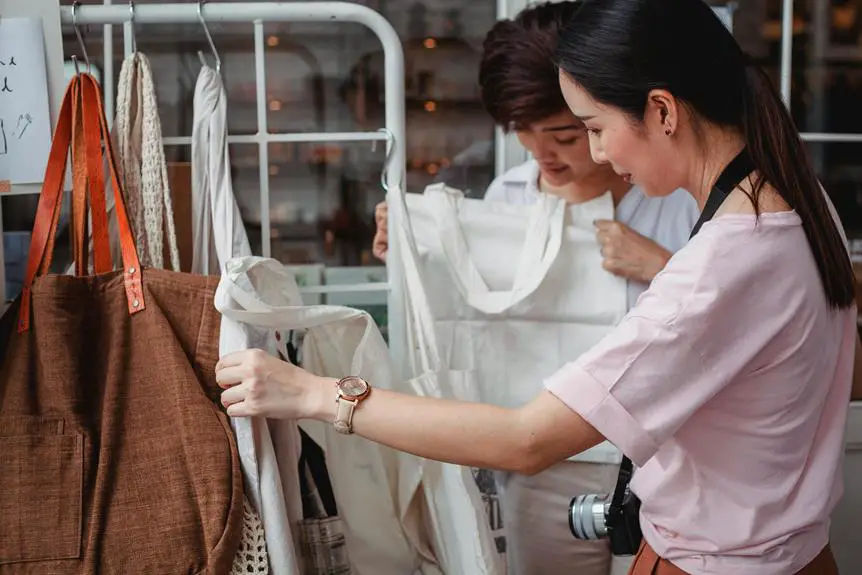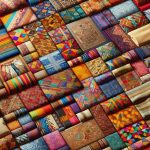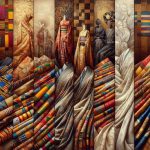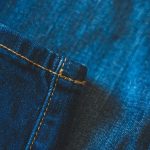You might be surprised to learn how brocade, often associated with luxury, is carving out its place in eco-friendly fashion. This intricate fabric, woven from natural fibers, not only offers durability but also champions sustainable practices through artisanal craftsmanship. By embracing local materials and ethical production, brocade aligns itself with mindful consumption and the slow fashion movement. Yet, the true impact of brocade extends beyond aesthetics; it intertwines cultural heritage with modern sustainability efforts. What does this mean for the future of fashion, and how can it reshape consumer choices?
Table of Contents
The History of Brocade
Brocade has a rich history that dates back to ancient civilizations, where it was prized for its intricate patterns and luxurious feel. You'll find its origins in places like China, where skilled artisans wove elaborate designs into silk fabric, making brocade a symbol of wealth and status. As trade routes expanded, brocade spread to the Middle East and Europe, gaining popularity among nobility and royalty.
In medieval Europe, brocade became synonymous with opulence. You could see it gracing the gowns of queens and the tapestries of grand castles. The fabric often featured gold and silver threads, elevating its allure. As the Industrial Revolution introduced mechanized weaving, brocade transitioned from handmade luxury to more accessible fabric.
Yet, despite its evolution, brocade remained a staple in fashion, especially during ceremonial events. Today, you might encounter this rich textile in haute couture and eco-friendly fashion, where designers honor its legacy while emphasizing sustainability.
Natural Fibers in Brocade
Natural fibers play a crucial role in creating the luxurious texture and intricate patterns that define brocade. When you choose brocade made from natural fibers like silk, cotton, or linen, you're not just opting for elegance; you're also supporting eco-friendly practices. These materials are biodegradable, reducing the environmental impact compared to synthetic fibers.
Silk, with its shimmering finish, is often the star of brocade fabric. It's produced by silkworms, making it a renewable resource when responsibly sourced.
Cotton, on the other hand, provides a soft, breathable alternative that's perfect for everyday wear. When organic cotton is used, you further enhance the sustainability factor, minimizing pesticide use and water consumption during cultivation.
Linen, derived from the flax plant, offers durability and a unique texture that can elevate any piece. It's also known for its low environmental footprint, as it requires less water and pesticides than cotton.
Artisanal Craftsmanship and Sustainability
Artisanal craftsmanship often embodies sustainability by prioritizing traditional techniques that minimize waste and utilize eco-friendly materials. When you choose brocade pieces crafted by artisans, you're supporting methods that have been passed down through generations. These artisans focus on quality over quantity, ensuring that each item is made with care and attention to detail.
By embracing these age-old practices, you help preserve cultural heritage while also promoting sustainable fashion. Many artisans source their materials locally, reducing transportation emissions and supporting local economies. You'll find that the dyes used are often natural and non-toxic, which not only protects the environment but also ensures that the garments are safe for wear.
Investing in artisanal brocade means you're likely to own unique, one-of-a-kind pieces that tell a story. Each stitch and pattern reflects the artisan's skill and passion, making your wardrobe more meaningful. By wearing these garments, you're not just making a fashion statement; you're making a conscious choice that prioritizes sustainability.
In a world of fast fashion, embracing artisanal craftsmanship is a powerful way to contribute to a more eco-friendly future.
Reducing Waste in Fashion
Reducing waste in fashion requires a shift towards mindful consumption and production practices that prioritize longevity over fleeting trends.
You can start by evaluating your wardrobe and identifying pieces that you truly love and wear often. Invest in quality over quantity; choose clothing made from durable materials like brocade, which not only looks beautiful but stands the test of time.
Consider buying from brands that focus on sustainable practices, as they tend to produce less waste overall. When you do shop, look for timeless designs that won't go out of style quickly. This approach helps you avoid the pitfalls of fast fashion, which often leads to discarded clothing filling landfills.
Another way to reduce waste is to embrace second-hand shopping. Thrift stores and online resale platforms offer unique pieces and extend the life cycle of garments, reducing the demand for new production.
Additionally, you can repurpose or upcycle old clothes, giving them a new lease on life rather than throwing them away.
Ethical Production Practices
When you think about ethical production practices, consider how sustainable material sourcing plays a crucial role.
Fair labor practices ensure that workers are treated well, while waste reduction strategies help minimize environmental impact.
Together, these elements create a more responsible fashion industry that you can support.
Sustainable Material Sourcing
Sustainable material sourcing ensures that the fabrics you choose not only look good but also support ethical production practices. When you're selecting materials for your wardrobe, consider using organic fibers like cotton, hemp, or linen. These materials require fewer pesticides and chemicals, which means a healthier environment for everyone involved.
You might also explore recycled fabrics, such as reclaimed polyester or upcycled textiles. By opting for these options, you're reducing waste and giving new life to materials that would otherwise end up in landfills. Additionally, look for suppliers who prioritize local sourcing. This reduces carbon emissions from transportation and supports local economies.
Another important aspect is certification. Fabrics that carry certifications like GOTS (Global Organic Textile Standard) or OEKO-TEX guarantee that the materials meet rigorous environmental and social standards. By choosing certified fabrics, you ensure that your fashion choices align with sustainable practices.
Lastly, don't forget to consider the longevity of the fabrics you select. Investing in high-quality, durable materials means your garments will last longer, reducing the need for frequent replacements. This approach not only enhances your wardrobe but also contributes to a more sustainable fashion industry.
Fair Labor Practices
Choosing eco-friendly materials is just the beginning; ensuring fair labor practices in the production of your clothing is equally vital for a truly ethical fashion industry. You want to support brands that prioritize the well-being of their workers, providing safe environments and fair wages. When you invest in fashion that respects labor rights, you're not just buying clothes; you're endorsing a movement that values human dignity.
Look for certifications and transparency in the supply chain. Brands that openly share their labor practices are more likely to adhere to ethical standards. Check if they conduct regular audits and maintain a commitment to fair treatment of workers. By choosing companies that prioritize these values, you're making a statement about what matters to you.
It's essential to be aware of the conditions under which your garments are made. Exploitation and unsafe working conditions shouldn't be part of the fashion equation. By demanding ethical production practices, you contribute to a system that supports fair labor and sustainable fashion.
Every purchase you make can reflect your values, promoting a healthier planet and a more just society. Remember, ethical fashion is about doing good for both people and the environment.
Waste Reduction Strategies
Implementing waste reduction strategies is crucial for brands aiming to minimize their environmental impact while producing eco-friendly fashion.
You can start by adopting a zero-waste design approach, which focuses on creating patterns that maximize fabric use. This way, you'll cut down on scrap material, turning what could be waste into beautiful, usable pieces.
Next, consider collaborating with local artisans who can repurpose leftover textiles. Not only does this reduce waste, but it also supports community craftsmanship and promotes unique designs.
You should also explore using biodegradable materials or recycled fibers in your production process. This choice significantly cuts down on harmful landfill contributions.
Incorporating a take-back program can further enhance your waste reduction efforts. Encourage customers to return old garments for recycling or upcycling. It builds brand loyalty while ensuring materials are reused rather than discarded.
Celebrating Cultural Heritage
Brocade fabrics not only showcase intricate designs but also reflect the rich cultural traditions that inspire eco-friendly fashion today. When you wear brocade, you're not just donning a piece of clothing; you're celebrating a legacy of craftsmanship and heritage.
Here are four ways brocade honors cultural heritage:
- Artisan Techniques: Each piece is often handcrafted, preserving traditional weaving methods that have been passed down through generations.
- Symbolic Patterns: The designs often carry historical significance, representing stories, mythology, or societal values unique to various cultures.
- Local Materials: Many brocade fabrics utilize locally sourced materials, promoting sustainable practices and supporting local economies.
- Cultural Events: Brocade is frequently featured in traditional ceremonies and festivals, helping to keep cultural practices alive in a modern world.
Frequently Asked Questions
What Types of Garments Are Commonly Made From Brocade Fabric?
You'll often find brocade fabric in luxurious garments like evening gowns, jackets, and formal wear. Its intricate patterns and rich textures make it perfect for creating stunning pieces that stand out at any special occasion.
How Does Brocade Compare to Other Fabrics in Terms of Environmental Impact?
When you compare brocade to other fabrics, you'll find its production often involves more resources and chemicals. However, its durability can lead to less waste over time, balancing its overall environmental impact in fashion.
Can Brocade Be Easily Recycled or Composted at the End of Its Life?
Brocade isn't easily recycled or composted due to its complex blend of materials. You'll find that many brocade fabrics contain synthetic fibers, making sustainable disposal challenging. Always check specific fabric compositions for better eco-friendly options.
Are There Any Famous Designers Known for Using Brocade in Their Collections?
Yes, several famous designers incorporate brocade into their collections. You'll find it featured in designs by names like Dolce & Gabbana and Alexander McQueen, showcasing its luxurious texture and intricate patterns in stunning, high-fashion garments.
How Can Consumers Care for Brocade Garments to Ensure Longevity?
To care for brocade garments, you should gently hand wash them in cold water, avoid wringing, and air dry. Store them in a cool, dry place, and use padded hangers to maintain their shape.
- How Does Ring Spun Cotton Affect Garment Fit and Shape Retention? - August 13, 2024
- What Are the Challenges in Producing Ring Spun Cotton? - August 13, 2024
- Is Ring Spun Cotton Suitable for Plus-Size Clothing? - August 13, 2024







